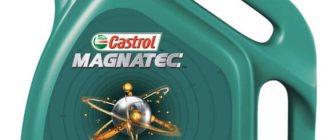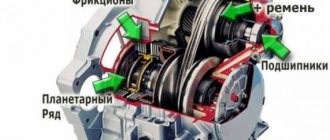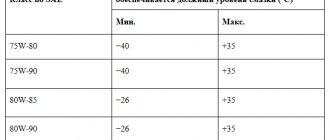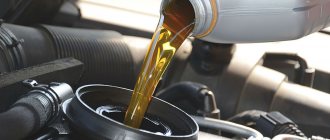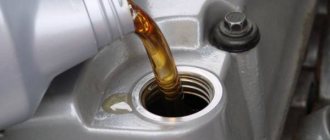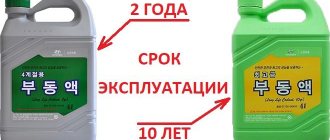Motor oil is the lifeblood of the engine, without which the power unit will not be able to function and will soon require appropriate repairs. The car owner will need to have the engine serviced on a regular basis to prevent various types of breakdowns. Adding oil to the engine with your own hands is not difficult. You just need to select a lubricant taking into account its characteristics and carry out the procedure in a timely manner.
Lubrication System - Brief Overview
One of the most important parts of a car engine is the mechanism for lubricating it - the so-called lubrication system. This system is able to effectively protect all internal elements of the machine from wear. To ensure stable and trouble-free operation of the entire engine lubrication mechanism over a long period of time, I advise you to carefully monitor its technological condition throughout all years of operation. Also try to fill it with new lubricant on time or change it to clean one.
In this article, I tried to tell you how you can independently control the amount of oil in the engine lubrication system, and also wrote about the consequences of neglecting this. What can happen if you increase or decrease the amount of lubricant in the lubrication system, I also tried to clearly explain how to correctly change the lubricant in a car engine.
So, let's start by checking the condition and amount of lubricant in the system. Some car owners of recently purchased cars do not understand at all and are not even aware of the consequences of incorrect actions when changing the lubricant. They don’t know how to properly fill the engine with lubricant when driving their car after purchasing it to the first service station.
But why spend money on maintaining your car if you can do everything yourself? At the same time, relying on the warranty from the manufacturer, they quickly forget the main tenets of car maintenance and cease to understand the basic principles of filling oil. They also do not take into account the fact that in the machine operating book all the basic tips for maintaining machine elements are clearly indicated.
By the way, it’s worth checking the lubricant level in the engine from time to time (this must be done once every 12-15 days), especially during long trips.
Important to consider! In order for you to avoid inaccurate information about the amount of lubricant in the engine, you should only check it cold.
In this case, the sequence of actions will be as follows
- First, locate the oil dipstick and the marks on it. Next, simply place your car on a flat surface (this is worth doing to measure and get more accurate values).
- Next, you should open the car hood and find a dipstick in the engine tank to check the amount of lubricant in the engine (usually the dipstick is a rod with a steel or plastic handle).
- Then take the dipstick and try to insert it into the oil fill hole.
- By the way, there are special value marks on the probes - these are MIN and MAX marks. Insert the probe all the way and try to evaluate your resulting value (the mark should be between these marks).
- By the way, if the lubricant level is within the tolerance, in this case it is worth putting the dipstick back in its place and closing the car. Try not to rush when pouring oil into the engine so that nothing spills out.
Used motor oil has a dark tint.
When checking the amount of lubricant in the engine, try to pay attention to the shade of the lubricant and the presence of an oily film. The color of the oil may vary depending on the mileage of the vehicle.
How to distinguish new oil in a car? New oil is usually always clear or has a slightly yellow tint. After driving 5 thousand kilometers on one bay, the oil turns into a thick, darkish mixture. Further, its shade only becomes darker.
After another few thousand kilometers traveled, the oil becomes even darker and acquires an almost black color during engine operation. In proportion to its thickening during driving and further darkening, the oil becomes unsuitable for use. Therefore, if I were you, I would not be surprised if after just a couple of weeks or a month of operation, the waste product comes out of the container like condensed milk. Try not to get dirty when replacing.
How to choose an oil filler cap
The elements of the motor group are operated in particularly difficult conditions and require a properly functioning lubrication system - it prevents the occurrence of dry friction and promotes the removal of excess heat. In addition, this system removes wear products, rust, etc. It will be no secret to any car enthusiast that engine oil needs to be changed regularly. Oil is supplied to the engine through the so-called. oil filler neck with a lid. Although the cover seems to be one of the simplest elements of the car, there is something to be said about it. In this material, Avto.pro will briefly review the operating principle and design of the oil system, its characteristic malfunctions, and will also talk about the method for choosing an oil filler cap.
Recommendations for filling lubricant
How to properly add oil to the engine? This question is asked by many novice drivers. The entire process of adding oil to the engine includes a number of basic operations that any motorist can handle.
Optimal oil level
Initially, you should open the hood of the car and secure it with a metal hook or rod. The hood of a car is usually opened by pressing a lever that is located below the level of the driver's left knee. Next, pull the lever under the hood.
After this, you need to find the oil filler neck sealed with a cap. It is located on the engine cylinder block. Usually there is an inscription “Oil Fill” on it or a marking of the viscosity of the oil used, for example, 5W30. The lid is unscrewed, wiped with a clean rag and left aside.
A funnel is inserted into the open space. It is necessary to prevent engine oil from spilling into the cylinders. Add oil in small portions. Turning oil containers upside down is not allowed. You need to pour about 200 ml per session, then wait 20 minutes for the engine oil to flow into the base of the crankcase. After a fresh portion of lubricant has settled at the base of the crankcase, its level is checked with a metal rod. If there is not enough car oil, you can repeat the topping up operation until the lubricant level approaches the nominal level, between the minimum and maximum values. The oil rod for checking the lubricant level must be wiped with a dry cloth before each check.
If a little motor oil gets into the engine area, then there is no need to panic. Lubricant residues become dangerous when a strong smell of burnt oil occurs after the engine warms up. It is advisable to clean the spill area with a dry cloth or paper towel.
When the engine fluid level reaches the optimum level, it is necessary to fix the oil dipstick and the filler cap back into place. The main thing is that everything is tightly screwed.
All unnecessary items are removed from the engine compartment, and the lid is closed. Next, you need to start the engine and let it idle for some time. At this time, the driver should carefully listen to the operation of the power device to identify extraneous sounds and noise. If the “Check Engine” sensor is triggered, the driver should immediately visit a car repair shop.
Now we know how to properly add oil to the engine, and whether it is possible to add oil to a hot engine. Timely topping up of lubricant allows you to save the life of your car engine. This means that all working parts of the power unit will be lubricated in a timely manner and protected from oil starvation and other undesirable factors.
Service frequency
The frequency of service work on a car engine will directly depend on the type of engine.
Typically, manufacturers advise performing this procedure every 12-15 thousand kilometers. However, in Russian conditions, the fuel is not of the proper quality and contains various additives that enter the lubricant and deteriorate its structure, so it is recommended to change the oil every 2 years or every 8-10 thousand kilometers.
If a car owner neglects the recommendations of the car manufacturer or uses low-quality lubricant, this leads to premature wear, problems with valves and cylinders may appear, and the turbine often fails.
Such an engine will require an expensive overhaul or a complete replacement, so experts do not recommend saving on service by performing this work at a service station or independently using original filters and high-quality consumables.
Reasons for changing motor oils
Any motor oil has its own expiration date when used inside an internal combustion engine. Thus, the loss of the physical and technical qualities of motor lubricant leads to increased wear of the engine power unit. Let's consider how different technical indicators of oil affect the operation of the power unit.
Loss of physical properties
The loss of physical properties of a lubricating fluid means loss of lubricating properties. When engine oil has lost these properties, increased wear of parts begins, which leads to abrasion of the cylinder walls, as well as the accumulation of metal dust. This contributes to the loss of the chemical qualities of the oil.
Loss of chemical properties
Motor oil, in addition to acting as a lubricant, also acts as a heat remover and protects structural elements. When its chemical properties are lost, the oil becomes very hot, but does not transfer the generated heat to the walls of the cylinder block, which does not provide additional cooling.
After the loss of chemical properties, the protection of the walls of the cylinder block disappears and scratches form on it, and the protection of the crankshaft also disappears, which causes increased wear of the journals.
Design and principle of operation of the lubrication system
The main purpose of the lubrication system of the engine and adjacent components is to reduce friction between the mating elements of the power unit. As already mentioned in the introduction, this system also promotes better engine cooling and removes wear products, carbon deposits, rust and dirt that can enter the system along with the oil. The main elements of the lubrication system are usually:
- Oil pan (metal or plastic) with oil intake;
- Oil filter;
- Pressure meter;
- Oil pump;
- Oil cooling radiator;
- A set of highways and canals;
- Bypass valves.
The oil pan is an oil storage container. There may also be several sensors: oil level and temperature. In the vast majority of cars, the oil level in the crankcase can be monitored using a dipstick. The lubricant is “driven” through the system far from under the influence of gravity. A special pump is responsible for oil circulation, receiving energy directly from the crankshaft or camshaft, and in some car models, from a specially dedicated shaft.
One of the requirements for motor oil is its purity. Because This is a liquid that comes into contact with rubbing and heating parts; it can collect wear products (example: metal shavings), carbon deposits, etc. A special oil filter is responsible for keeping the oil clean. It is recommended to change it simultaneously with replacing the lubricant. The latter, gaining heat from the running engine, is cooled in the radiator. Heat from the radiator is taken away by the flow of antifreeze from the engine cooling system. Bypass valves solve the problem of a possible increase in pressure to dangerous levels. Pressure readings are monitored by a separate sensor.
The lubrication system of the vast majority of modern cars is combined . This means that some of the rubbing parts are lubricated with oil under pressure, while the remaining volume of lubricant splashes or moves by gravity. Moreover, regardless of the design of the system, it will be cyclic, i.e. the oil is pumped in, filtered, “driven through,” cooled, and then the cycle is repeated. In the simplest case, the system works like this:
- When the engine starts, the oil pump comes into operation. An important point: a thin oil film already covers some of the rubbing parts, so the risk of dry friction is minimal, but it is still worth warming up the lubricant at idle;
- Oil from the sump moves through the oil filter, the main oil line and gets to the connecting rod and main bearings, as well as the camshaft cams and bearings;
- From the front main bearing, the oil moves to the timing drive and cylinder head, forming an oil bath that lubricates the rocker arms, valves, pushers and other engine elements;
- At the same time, oil enters the connecting rod channels, and in some systems it is sprayed with special oil nozzles;
- Oil droplets form the so-called. oil mist near some moving parts, but most of it flows back into the crankcase.
Why does an engine need lubrication?
ICE is an internal combustion engine (carburetor or fuel injector) that cannot function without motor oil. It performs the following important functions:
- Prevents scuffing and reduces friction between the surfaces of power unit parts that are in contact with each other.
- Seals gaps between compression and oil scraper rings of cylinders and pistons. Due to this, the risk of heated gases entering the engine crankcase from the combustion chambers is minimized.
- Increases the service life of the internal combustion engine, reducing the wear of its individual elements.
- Protects metal parts from oxidation, thereby preventing their corrosion.
- Removes heat from rubbing mechanisms.
- Removes varnish deposits, sludge, and slag from the power unit.
- Changing the oil in the VAZ 2114 engine - everything the owner needs to know
- Changing the engine oil - the whole sequence of actions and error prevention
- How to check the oil level in a car engine - use a special dipstick
An excessive amount of MM causes the appearance of coke and carbon deposits in the cylinder-piston mechanism, difficulty starting the internal combustion engine in winter, foaming of the lubricant, and wear of valve bushings. In cases where the oil level in the engine is insufficient, its parts begin to function dry. This leads to the formation of air pockets inside the system, uneven rotation of the crankshaft, and jamming of the cylinder pistons.
This is interesting: Do you need to add water or electrolyte to the battery?
Reasons for increasing oil thickness levels
Usually this is the penetration of any soft objects or third-party liquids into the car crankcase (antifreeze or automobile fuel may well get into the crankcase). By the way, when the internal gaskets wear out or when cracks appear, the technical mixtures in the engine are changed while driving. As a result, noticeable symptoms of engine failure may appear (blue or sulfurous smoke billows from under the hood).
To avoid any problems when driving a car, it is recommended to find out in advance how to fill the lubricant or replace the lubricant in the engine.
Why change it?
Generally speaking, motor oil is a patient product. And if you create heavenly conditions for it - a clean, brand new engine, medium speeds, low loads (read: operation without overheating), then it will last longer than smart books say. But heaven is where we are not. In real life, oil begins to age literally from the moment it moves from a sealed canister into the labyrinths of the engine. Its oxidation begins, accelerated by constant heating and cooling, detergent additives leave, and dirt accumulates. There is nothing unexpected in all this: the oil must not only lubricate and cool, but also wash the engine, and also remove various impurities from it. But it is quite obvious that the rate of aging of motor oil greatly depends on its operating conditions.
Flushing: to do or not?
A separate topic concerns the question of the need to flush the engine when changing the oil. In short, we can say that if this is necessary, then you need to do the flushing with the same oil that you will use to fill the engine. Avoid using special cleaning agents, especially for five minutes. They can cause serious damage to your engine.
So, flushing will be required when switching from synthetic oil to semi-synthetic, as well as from semi-synthetic to mineral. When switching from mineral to semi-synthetic and from semi-synthetic to synthetic, flushing is not required.
If one brand of oil is replaced by another, you should also flush the engine, but again with the same product that you will use to fuel the engine. Flushing will also be required when purchasing a used car with an unknown history, as well as in some other cases.
( 2 ratings, average 4 out of 5 )
Stage one - preparatory
We drive the car out of the garage, warm up the engine, to do this we let the car idle for ten minutes. This is necessary so that the oil heats up and flows out of the engine easily. Cold oil will be more viscous, will flow slowly, and a lot of old oil will remain on the walls of the engine crankcase. While the car is warming up, we build an overpass from two pieces of wooden beams 150x150x400 and two boards 50x150x1200, as shown in the photo.
We drive slowly and carefully along the boards to the top of our overpass.
How is it determined how much oil is in the engine?
Any car owner has the opportunity to find out for himself how much oil to fill his car and where to fill the engine oil. Typically, the required amount of motor lubricant is prescribed in the owner's manual for the car.
The amount of oil is set with the engine turned off, either ten minutes after it is completely turned off, or before starting. To ensure correct measurements, the car must be on a horizontal, smooth surface.
Included with any car is a special dipstick for measuring car oil. It is usually located in the front area of the motor and looks like a thin metal strip with marks on it.
In order to get the dipstick, you need to grab the ring handle and pull it in your direction. Wipe it free of liquid, immerse it completely in the motor and lift it up again.
The volume of motor oil is set by divisions. If the lubricant has reached the upper mark, there is no need to add oil to the engine. If the fluid level approaches the lower mark, you need to fill the engine with oil.
Adding lubricant - minimum difficulties
Correctly adding oil to the engine is not difficult. The operation is performed according to the following algorithm:
- The machine is placed on a level surface and the handbrake is applied.
- The car hood opens and is secured with a rod.
- The engine warms up and turns off.
- There is a locking cap at the top of the power unit. It usually contains the inscription Oil Fill or an oil can icon. The lid is unscrewed, wiped with a dry cloth, and set aside.
- Using a dipstick, the MM level is checked.
A funnel (either factory-made or made independently from a plastic bottle) is installed in the oil filler neck, through which oil is added. It is allowed to add 150–250 ml of liquid at a time.
After filling a portion of MM, you must wait 20–25 minutes and again check the amount of lubricant with a dipstick. If necessary, the latter is added according to the scheme described above until its level is established between the MAX and MIN marks on the testing device.
At the end of the operation, surfaces on which drops of liquid have fallen are wiped with a clean cloth. The dipstick is put in place (pushed in until it stops). The lid is screwed on and the hood is lowered. Adding oil is complete.
It is recommended to start the engine and let it run for 5–10 minutes. If the power unit does not make any extraneous sounds, the machine is ready for use. If you notice unusual noises, you should immediately contact a specialist service station.
“My car will tell you when to add oil.”
We are accustomed to the fact that all cars have indicators on the instrument panel with a picture of an oil can or the inscription OIL. Many drivers do not bother checking the oil level, hoping for help from the on-board diagnostic system. But this is not always justified. The fact is that that same indicator indicates a problem with the oil pressure, and not its level. In simple terms, the oil pump takes oil almost from the very bottom of the pan. Accordingly, as long as it exists in principle, there will be no problems with pressure in normal modes. They can occur during sudden maneuvers, driving uphill or downhill, and only then air will enter the pump and the light will come on. So it is wrong to rely on a familiar indicator in terms of level control.
To change the lubricant in a car, you should do the following:
- Place your car with a warm engine in a garage pit or on an overpass, if you have one. Next, simply open the hood and remove the neck from the engine drain hole.
- At the same time, place an empty container under this neck, then manually unscrew the drain cap.
- When everything goes out, carefully pour new clean oil into it and turn on the engine. Also, don’t forget to fill the engine with oil through the filler neck. What to do next? Just turn the cap and screw it back to its original position - back.
- At the end of the procedure, all you have to do is turn on your car and check that the pressure level warning light has stopped lighting.
- I also hope it will not be a discovery for you if the lamp does not light up when you turn on the engine for the first time. Typically, the system needs about 20 seconds for the motor to develop the pressure necessary for its operation.
Correct sequence of actions when topping up
Let's look at how to add oil to the engine step by step. To do this correctly you need to adhere to the following algorithm:
- The vehicle must be placed on a level surface. The engine needs time to cool so that the lubricant can drain into the sump. This will take approximately 10 minutes. First, you need to open the hood of the car to get to the oil filler neck (it is located in the upper part of the cylinder head). We open the hood using the lever, which is located in the cabin at the level of the driver’s left knee or slightly lower. Then open the hood and fix its position using a rod.
- We use a special dipstick located under the hood to measure the lubricant level. The dipstick must first be wiped with a dry cloth. An oil trail will indicate the level. We top up when the mark drops below the “minimum” value.
- The neck cap is closed with a threaded plug and is marked with the symbols “Oil Fill”, or the viscosity characteristic of the lubricant, for example, 5w-30. Some models have a pictogram in the form of an oil can with a drop. The distance between the marks on the dipstick is equivalent to 1 l. lubricant.
- Insert the funnel into the neck and carefully add oil. If drops get on the drive, wipe off any oil traces with a rag.
- First, pour in 250 ml of lubricant and pause for 5-10 minutes. During this time, the oil will drain into the pan. We check the level with a dipstick and add no more than 250 ml. Topping up and checking are repeated until the level is between o and “maximum”.
- We return the oil dipstick to its place. Screw the neck cap tightly. We remove foreign objects and wipe places where there may be oil residues.
All that remains is to start the engine and listen to its work. The oil indicator should not light up. If, after topping up, it still signals a low level, you should contact a service station to identify the causes of the failure.
Remember that excess oil increases the pressure in the internal combustion engine, which can lead to failure of the power unit. Don't neglect simple rules. Good luck on the roads!
Do you already know when to change the oil in your car's gearbox?
Tell me, when you were looking for information on the request “changing transmission oil”, did you come across the statement that it is not necessary to change it at all? There are a lot of misconceptions on the Internet about checkpoint maintenance that are far from the truth. Practice shows that any lubricants lose their properties over time (oxidize, additives are depleted, fumes appear) and need to be replaced.
So, when does the moment come when you need to buy and change the fluid in the box?
First you need to decide on the type of checkpoint:
- automatic (automatic transmission);
mechanical or manual (manual transmission);
dispensing room (RK).
The manual, or technical manual for your car model, contains information about gearbox lubricants. It indicates after what period of time or mileage to replace it, how many liters of oil are in the box, and what kind of transmission oil to fill.
Often, box manufacturers recommend changing the lubricant every 60-90 thousand. km, and in difficult operating conditions - 2 times more often. Also, the oil volume in the gearbox differs, which can range from 1.2 liters to 15.5 liters, depending on the type of gearbox itself.
Do you have additional questions about how and when should the oil be changed in a transfer case, automatic transmission or manual transmission? Then contact our experts by phone and get practical recommendations on working with lubricants.
What does excess or lack of automotive lubricant lead to?
Any experienced driver will tell you that the oil level with a warm engine should be at the mark between the lower and upper bars of the mechanical dipstick. How to measure the amount of motor oil?
Checking the oil level
Is it possible to add oil to a hot engine? The answer is that it is not advisable, since the level readings will be incorrect, and you can get burned during the procedure. It is recommended to check the level “cold”, after a night of inactivity, or through an express check, which consists of the following. First, you need to warm up the engine power plant to optimal operating condition. A short trip is an excellent way to warm up the engine. After this, the vehicle should be secured on a flat surface, turn off the engine and wait about 20-30 minutes. This is necessary so that the oil mass flows into the oil pan. Next, the lubricant level is measured.
Excess oil
Before adding oil to the engine, it is necessary to take into account the main mistakes that novice drivers make. Most beginners believe that you can pour oil as much as you like or you always need to maintain the level at the maximum level of the oil rod, the effect will only be better.
This is a mistaken opinion, “porridge can be ruined with oil,” that is, the engine will suffer greatly from overflowing consumables.
The first consequence is poor engine crankability. This is explained by the fact that any motor fluid has a certain viscosity, and its excess amount in the system creates additional resistance. Working parts spend more energy moving. This results in increased fuel consumption, but this is not the worst thing.
During operation, the lubricant begins to expand in the vehicle’s engine system. In a high-temperature environment, increased pressure occurs, which has a negative effect on all seals of the operating device. All seals and gaskets begin to squeeze out over time, and engine oil leaks. Crankshaft oil seals are especially sensitive, since the lubricant is supplied under pressure. As a result, the entire interior of the engine becomes dirty, and the seals must be replaced. In addition, there are a number of other consequences of overfilling: it is difficult to start the car in cold weather, “sticking” of piston rings, foaming of the oil composition.
Lack of consumable oil
Lack of lubricant also has a detrimental effect on the vehicle’s power plant. The effect of oil starvation of working units and mechanisms appears, that is, at the moment the engine starts, oil flows to the moving parts in insufficient quantities. A small volume of lubricant is not able to form a strong film to reduce contact between metal surfaces.
Lack of optimal amount of lubricant in the engine allows air pockets to appear, which will be distributed throughout the system.
The crankshaft will begin to operate without lubricant, resulting in the formation of fine metal dust, which will subsequently enter the engine fluid. Over time, there is a high probability of piston jamming.
It is for these reasons that it is necessary to regularly check the lubricant level and add it if necessary.
When to add oil to the engine?
The question is rather rhetorical. Of course, immediately after detecting a low level. As a rule, the car owner knows what the car's lubricant consumption is. By regularly looking at the odometer, you can accurately determine the need to replenish the volume. At the same time, no one canceled regular monitoring.
If there are 1000-1500 km left before the next scheduled maintenance, there is no point in wasting fresh engine oil on topping up. Perform maintenance ahead of schedule. At the same time, you should purchase new oil with a reserve, since you know exactly how much fluid will have to be added during the service period.
How to add oil to the engine correctly. Part 3
Author Sergey Bukhransky
Updated: 06/30/2019 21:53 Published: 05/20/2019 09:21
Auto
We continue the article about the intricacies and features of correct oil addition. It turns out that many people do not know certain rules, which leads to early engine wear. Therefore, we will try to cover this topic completely.
7 shared
Where should I add oil?
On the one hand, many will smile, because almost everyone knows where the valve cover is located on the car, where the missing oil should be poured. But it's not that simple. Indeed, in most cars the valve cover catches the eye immediately after opening the hood, but many new cars have maintenance-free engines, and in order to get to the neck of the valve cover you need to remove the plastic engine protection and look for the neck exactly under it. But it should be noted that most often the valve cover is located on this plastic protection.
How to top up, on a hot or cold engine?
We must immediately put an end to this dispute; any procedure for adding oil to the engine should be carried out only on a cold engine. All disputes on this topic must be stopped; pouring oil into a hot engine is prohibited. You must immediately remember that if you pour cold oil into a hot engine, this can lead to serious malfunctions. As a result of a sharp change in temperature, cracks may appear on some engine parts and the geometry of the engine may generally change. Therefore, in any situation, you should wait until the engine cools down and only then add oil to it.
You also need to remember that the correct oil level can be determined with a dipstick only on a cold engine, when all the oil has drained into the pan. You should also check the actual oil level at least once a week in order to renew it in a timely manner if necessary.
When and how much oil to add is decided by the driver himself. It all depends on the engine itself. The most correct level would be in the middle, between the minimum and maximum. Moreover, it is not advisable to overflow. Sometimes car owners believe that the more oil, the better. However, this is wrong. Excess oil leads to increased pressure and can lead to serious engine damage.
Can I add oil myself?
Sometimes motorists are afraid to carry out such work themselves. But this is exactly the case when even a fragile girl can cope with it. It is important to remember some of the rules mentioned above. Oil must be poured into a cold engine and adhere to the middle mark on the dipstick. If the oil level on the dipstick is seriously reduced, then you should pour oil in portions. That is, you can immediately splash five hundred grams, then wait ten minutes and check. If the level is lowered again, then you can add another five hundred grams.
Photo: proavtomaslo.ru
Don't forget to subscribe to the Auto Column channel in Yandex.Zen. We intend to continue telling our readers something that will surprise you...
Typical beginner mistakes
Novice drivers often make the same type of mistakes, leading to difficulties in operating the engine. In some cases, serious damage occurs, which can only be eliminated by opening the motor and replacing damaged elements.
These typical mistakes of novice drivers include:
- using inexpensive and low-quality mineral lubricant instead of original synthetic oil;
- filling the engine with oil to the maximum, which makes it difficult to start the engine;
- underfilling of oil causes increased wear or wedging of the crankshaft.
The parameters of the lubricant used must be fully suitable for the characteristics of the engine. For gasoline and diesel engines, their own types of oil are produced, which must be taken into account when choosing it. Attempts to save on the frequency of service work performed or the quality of technical fluids used will invariably lead to serious breakdowns, the elimination of which will require significant financial costs.
Car maintenance is not difficult, so you can do this work yourself, saving on service calls. You just need to correctly add oil to the engine, select the correct type of lubricant and its technical characteristics. This will be the key to quality vehicle maintenance. For such work you do not need to use any special tool; a simple open-end wrench, a flat-head screwdriver, an old bucket or a suitable container with a volume of 5-8 liters is enough.
- How to fill engine oil correctly?
- How should you fill engine oil correctly?
- What kind of oil should I fill in?
- When should you fill up engine oil?
To determine the actual role of motor oil in the fate of a car, we first list its operational tasks. It always supports:
— the components of the internal combustion engine are clean;
— lightness of the engine and its excellent pumping during cold starts;
— heat removal from heated elements of the power unit;
— reliability of engine operation at extremely high temperatures in the area of the cylinder-piston system;
— reliability of lubrication of engine parts;
— ensuring the elimination of aggressive corrosive substances that accumulate during operation.
To impart the necessary performance characteristics or improve existing ones, special additives are used. They must be added directly to the oil.
How should you fill engine oil correctly?
First of all, read the instructions and prepare the required amount of engine oil with the appropriate markings for consumables. To be completely sure that you have purchased a truly high-quality product, buy oil at specialized points where you will be provided with a documented quality guarantee. Don't forget to buy an oil filter as well.
To avoid problems during the oil change procedure, you should drive the car onto an overpass or inspection pit. Prepare a special container for draining used oil. What actions need to be taken?
1. Secure the vehicle so that it cannot move. Put the car on the handbrake. It must stand exclusively on a flat plane.
2. Warm up the engine to operating temperature.
3. Turn off the power unit and open the filler neck and pour flushing fluid into it.
4. Close the filler neck, turn on the engine and leave it running until the corresponding oil pressure light comes on.
5. Stop the engine and drain the used oil from the pan.
6. And now you will find out where to fill the engine oil. Unscrew the oil filter and fill it with a new portion of oil.
7. Screw the pan plug and put the oil filter back in.
8. Oil must be filled to the required level, which is indicated on the dipstick.
9. After carrying out the work, start the engine at low speed to check if there is a leak somewhere.
10. Checking the oil level is carried out exclusively on a flat horizontal surface. This must be done to correctly determine the level of filled consumables. If the oil has not reached the required level, add more.
Many motorists are wondering how much engine oil to fill? It is impossible to answer this question unequivocally, because each vehicle model requires its own specific amount of oil poured. Domestic cars need to be filled approximately within four liters. Experts advise initially pouring three liters, lowering the dipstick and checking the oil level. The dipstick is located next to the engine and looks like a thin metal stick with a plastic handle. If necessary, add material. Foreign cars with an engine capacity of 2.0 to 2.4 liters must also be filled with up to four liters, and then as in the previous case. Larger engines therefore consume more engine oil.
